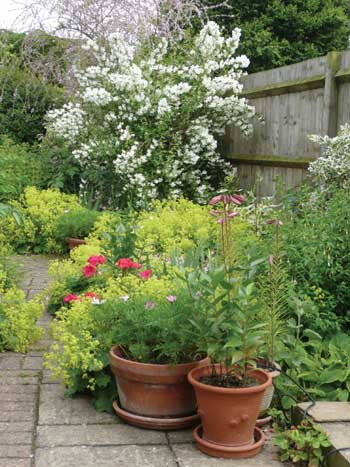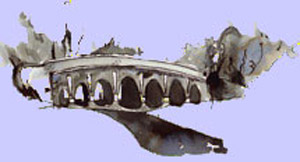 |
We have been living in this house now for over 20 years and during that time the garden has gradually evolved with many changes, usually quite small. There are still plants here that were already well established when we arrived but are now beginning to look past their best. The lawn has gradually reduced in size as flower beds widened and lawn care seems an increasing chore. Some changes have been inevitable as plants have died having reached their allotted lifespan, or succumbed to adverse weather conditions. Some favourite plants did not manage to survive the record low temperatures at the start of last winter. Shrubs seem to have been the worst affected and as these are larger plants, their loss has made greater impact on the garden. |
A cistus, a hebe and a rosemary all failed to survive, also several potted agapanthus plants. The decision has been whether to replace these plants and hope that we do not have such record low temperatures again for a while, or use their loss as a basis for greater changes.
We have been living in this house now for over 20 years and during that time the garden has gradually evolved with many changes, usually quite small. There are still plants here that were already well established when we arrived but are now beginning to look past their best. The lawn has gradually reduced in size as flower beds widened and lawn care seems an increasing chore. Some changes have been inevitable as plants have died having reached their allotted lifespan, or succumbed to adverse weather conditions. Some favourite plants did not manage to survive the record low temperatures at the start of last winter. Shrubs seem to have been the worst affected and as these are larger plants, their loss has made greater impact on the garden. A cistus, a hebe and a rosemary all failed to survive, also several potted agapanthus plants. The decision has been whether to replace these plants and hope that we do not have such record low temperatures again for a while, or use their loss as a basis for greater changes.
As the lawn had gradually reduced in size as flower beds widened and the lawn mower was getting older and older, we made the decision last autumn to remove the lawn once spring arrived. This we have now done and have replaced it with a large area of gravel joining up two smaller gravel gardens. In the middle we have made a raised bed using railway sleepers. Last autumn I potted up some perennials which had seeded themselves around the garden and kept them in the cold frame over winter. Most have survived and I have planted them in the new bed where they are establishing well, spending winter in the cold frame appears to have helped them develop into stronger plants. The irrigation system has been extended around the edge of the gravel so that the whole area can be used for pots both of flowers and crops which can then be altered and rearranged as the summer season progresses. I have several lilies in pots which should look good against the gravel.
Another significant feature of the garden which was here when we moved in is a large clematis Montana Rubens which had been planted alongside a climbing rose, both climbing up the back wall of the house. The clematis has put on a beautiful show year after year but we have not always managed to give it the pruning it required to keep it under control. Flowering on the clematis is now diminishing and I have reluctantly reached the decision that severe treatment is needed. I plan to plant a replacement clematis but at the other end of the wall as it is not a good idea to plant a new clematis in the same spot as an old one, this can encourage disease. We will then cut the old plant right down, hopefully without damaging the rose. Following repair of the trellis it should be possible to rejuvenate the rose and we will wait and see if the old clematis recovers. Hopefully the back wall should then play host to an improved rose and to two clematis plants which will be more controlled. It will be a while though before we can expect the show of flowers that we have become used to in past years.
It can be hard deciding that favourite plants are now past their best, sometimes this decision is made for us by time or weather. I am looking forward to seeing the new flower bed develop, and to playing around with arrangements of pots. The garden needs to be allowed to evolve and change giving new plants the chance to flourish, and I am sure these will, in time, become new favourites. |




